If you have psoriasis, you may have tried coal tar ointments. These are sometimes called
"LCD" ("Liquor Carbonis Detergens") compounds. Coal tar has been used as psoriasis treatment for years. I won't spend
time discussing its advantages or disadvantages compared to other treatments, but will simply note that in my own
experience it's the only thing that consistently works.
Coal tar by itself is usually a liquid, and is difficult to apply without making a mess, so it is better when mixed
into an ointment. Many dermatologists prescribe the coal tar along with some sort of steroid-based products for an
extra kick.
So this brings us to the subject of this article: Where can one find a pharmacy that will "compound"
the coal tar and the other products into an ointment?!? I for one am finding it more and more difficult to
find a pharmacy that will consistently do this.
The solution? Compound it yourself!! Here's how.
It's DISCLAIMER time: Please note that I am not recommending coal tar as a solution to psoriasis. This article is written simply to help you MAKE coal tar ointments if you (or your dermatologist) decide they are best for you.
D.I.Y. Compounding, "V 2.0":
I wrote this article originally in 2019. The original version is below. In the article I described adding
coal tar to Aquaphor ointment. But my emphasis was to show the various stages of creating this compound. It was a bit of
trial and error, and as a consequence I did not keep track of how much coal tar to add. I ended the article
with pictures of the various tints of compounds made with too little coal tar, too much coal tar, and the right amount, and
promised to update the article.
Well, here's the promised update, 5 years later! I have used that jar of homemade compound throughout these five
years. I apply a small amount each time, and my psoriasis has become quite mild - likely due to improvements in my
diet throughout the years. When your diet is very anti-inflammatory, auto-immune diseases seem to become more and
more mild. I had had 3 to 6 psoriasis plaques at any given time throughout this period, most in the same places, and
they required just a dab of the ointment only every week or couple of weeks.
My original method was to make coal tar compound "from scratch"
with Aquaphor. One tube of Psoriasin ointment (readily available in stores). Note that Psoriasin has only 2% coal tar, likely due to restrictions sponsored by the pharmaceutical companies. One 15 gram tube of Triamcinolone (or any other prescription compound). The OTC hydrocortizone ointments may not be quite strong enough. A small amount of Coal Tar. Please see the original article below for info on obtaining it. And that's it!! |
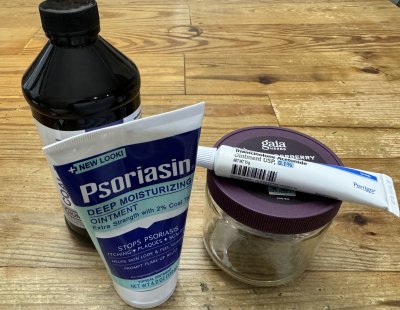 |
Squeeze the small tube of the prescription compound into a container.
Note that this time, I used only one 15 gram tube this time, whereas I used 30 grams last time. It's my opinion that
the coal tar is the key ingredient. |
Mix the two ointments |
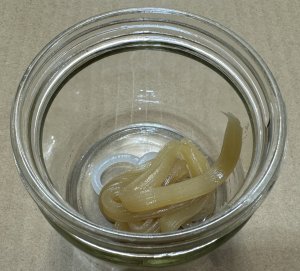 |
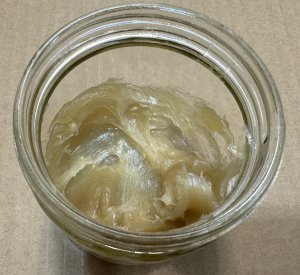 |
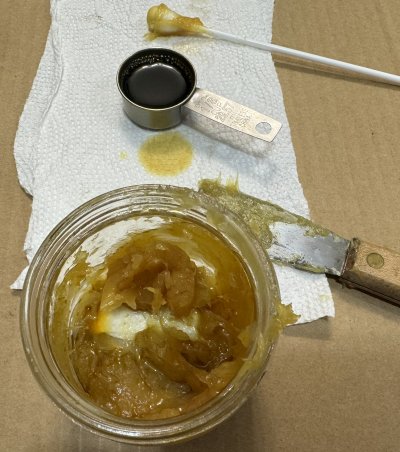 |
Add three teaspoons (0.5 oz) of Coal Tar. Try to use an "official" teaspoon
baking tool, not an ordinary teaspoon. The author is "not" responsible if you use one of the chef's measuring
utensils. . . |
The Finished Compound
Here is the finished compound. I have added all the rest of the Psoriasin
and the remaining Triamcinolone |
And this picture was taken of the finished compound on my kitchen table, with
light from the dining room window. |
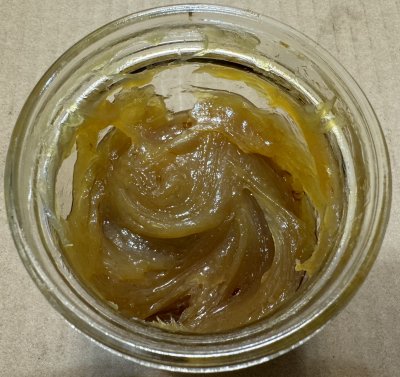 |
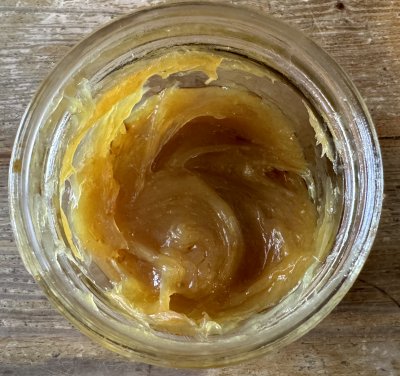 |
Not strong enough? Try your compound. I have found coal tar to be much better than any prescription ointment. A small psoriasis plaque should be amost gone in a couple of days, maybe three. If not, add another half teaspoon of Coal Tar and re-mix. As noted in the original article below, my dermatologist said "Feel free to add more Coal Tar if necessary".
Light Sensitivity: I don't know if this compound is light sensitive or not. In my case, I don't care because it stays in a closed drawer in my bathroom. If you are going to leave it out, an opaque container might be in order.
D.I.Y. Compounding, "V 1.0" (The Original Article):
So here's what you will need to make your own coal tar compound:The coal tar itself (Duh!) Humco is one supplier. The bottle shown is "prescription strength"
20% coal tar, along with alcohol and also polysorbate 80 (an emulsifier). Possibly other prescription ointments. Several dermatologists have written prescriptions for me that have contained topical corticosteroid ointments. They do seem to enhance the effect of the coal tar itself. Examples Fluocinonide. My original prescription (years ago) included this. But the manufacturer has within the last two years artificially raised the price to $280 for 60 gm! Insurance balked. Chlorbetasone Triamcinolone. This is what my doctor chose. It's in image on the right. One or more plastic, nalgene, or glass containers with wide lids. Some way to measure ounces. (Not from the kitchen! You'll catch h_ _ _ from the cook!) Oh, and don't do this in nice clothes! |
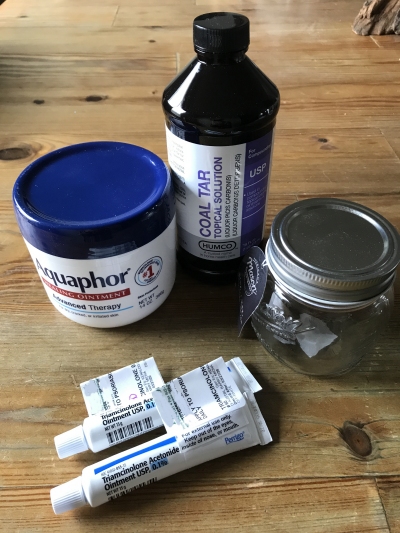 |
When I told my dermatologist of my difficulties in finding a pharmacy which would do compounding, he fully supported my plan to do the compounding myself, and readily gave me the formula. Here it is:
2 oz of the 20% coal tar.
60 gm of the corticosteroid ointment, in this case, the Triamcinolone.
Add sufficient Aquaphor to end up with 6 oz total. (Want to sound like a good compounding tech? The compounding term for this is "q.s", or "qs". That's the Latin for "quantum sufficit", or "the amount that suffices". So you say "Add Aquaphor qs to 6 oz")
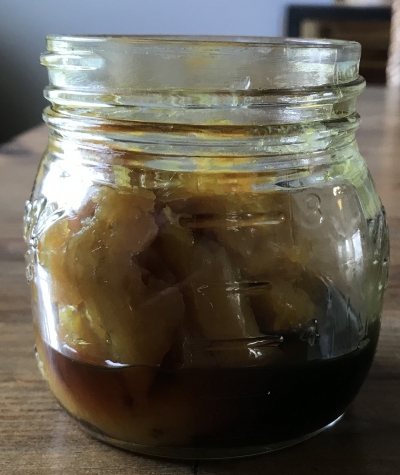 |
First attempt:Well, I got off to a bad start. The image on the left shows how NOT to do it!!
My first attempt was to pour the liquid coal tar into the container, so I could measure it. Then I squeezed
two of the 15 gm tubes of ointment and tried to mix the coal tar with the ointment. |
Compounding SUCCESSSo what you do instead is place the ointments in the container first. Then you
add the liquid Coal Tar. It's a lot like mixing the Thanksgiving gravy. Add the flour to the turkey drippings a little bit at
at time, stirring constantly. Add water (if desired) a little bit at a time while stirring. If you add the flour to some water
and then attempt to pour in the turkey drippings, it will be lumpy! First: Squeeze the corticosteroid ointment(s) into the container. In this case, I started with 30 gm of the Triamcinolone - 2 of the 15 gm tubes (instead of the suggested 60 gm). Why? Because I like to follow the rule: "Use the least amount of medication to do the job". Add about the same amount of the Aquaphor. Now add a small portion of the liquid coal tar. Stir well. You will find that they mix easily. Keep adding portions of the coal tar and mix well each time. I stopped at somewhere around 1 oz instead of 2 oz. (SEE below) Then add the Aquaphor, a little bit at a time, until you reach the 6 oz goal. You "qs to 6 oz". NOTE: "hydrophobic" vs "hydrophilic": |
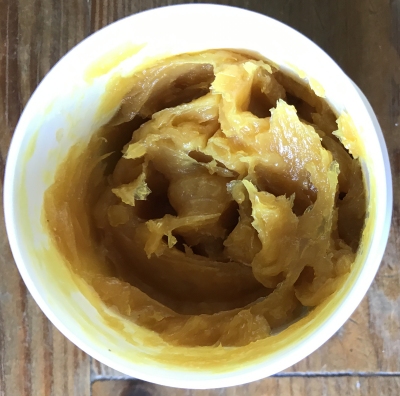 |
|
So. . . how much of the Coal Tar to add: The prescriptions that I have always got for the pre-compounded Coal Tar ointments called for "10% LCD
plus XX% cortiosteroid. It was never clear to me what that "10%" actually meant, and it was apparently not clear to the
various pharmacy compounding techs either. The original mixtures I received years ago were usually fairly dark brown
and had the distinct coal tar odor. But the most recent compounds have been a light almond color, with much less of the
smell. The one on the left is too strong. I added approximately 1 to 1 1/2 oz out of the original 2 oz of liquid that I poured out of the Coal Tar bottle. (This is the liquid that you see in the "First Attempt" image above.) The one on the right is too weak. It was the last pre-compounded prescription that I received. But the compounding tech apparently interpreted the "10% LCD" in too weak a manner; this batch did not work well at all. The container in the middle looks like the original mixture that I used to get for years. It is quite effective. Thus I recommend that you add sufficient Coal Tar to produce that tint. It's also shown in the image just above, under "Compounding SUCCESS". Yes. I know "sufficient Coal Tar to produce that tint" is a bit nebulous! When I mix the next batch, I will take note of the amount of coal tar used, and will update this article. When my doctor gave me the formula above, he actually did say that if I found it too weak, to feel free to add a bit more Coal Tar. This implies that the actual amount of Coal Tar can vary. |
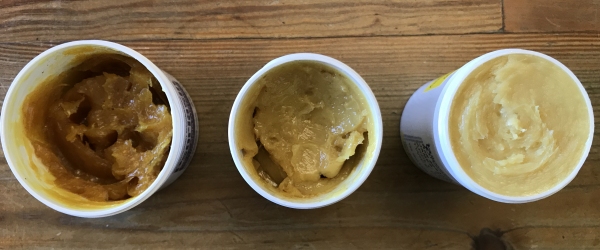 |
Copyright © 2024 J.A.